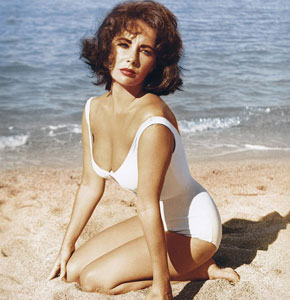The time was 2 a.m. and the voice of Elizabeth Taylor rang around the hotel lobby in Salzburg, Austria, as brimful of hellcat fury as any tempestuous heroine she had ever played on screen.‘Richard!’ she screamed at her fifth husband, Richard Burton. ‘Will you stop drinking and come to bed this minute! Your voice is ricocheting all over this hotel.’
It was a snowy night in 1968, and Taylor, acknowledged to be the world’s most beautiful woman, hardly looked the part at that moment. Her hair was a tangled mess, her Cleopatra-style eye make-up had gone smudgy. She wore a tatty black leather coat over a tarty red chiffon nightdress, and was barefoot.
Burton still wore a Nazi officer’s uniform for his role in the Alistair MacLean war story Where Eagles Dare. After the day’s filming, he had stayed up drinking vintage brandy with companions, including me, while Taylor had retired to bed. To complete the drama of her reappearance, Burton was being threatened with a handgun by a pushy expat American he’d just told to get lost. The gunman now looked on, as dumbfounded and dazzled as the rest of us.
|
| Mesmerising: Elizabeth Taylor, pictured here on the set of Suddenly, Last Summer |
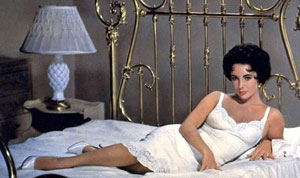 |
| Scorching: Taylor smouldered on screen including in the 1958 classic Cat On A Hot Tin Roof |
‘Either you come up now,’ Taylor hissed at Burton, ‘or don’t bother to, ever again.’
‘Aah, get away,’ snarled Burton, reaching for the brandy bottle. ‘Get away yourself,’ Taylor hissed. And, clutching her leather coat more tightly around her, she stomped back to their suite on her own.
Next morning on location, however, all was sweetness and light again. Taylor called Burton ‘Boofy’, he called her ‘Ocean’, and between takes they canoodled like lovestruck teenagers.
‘My dear, you light up the set,’ the film director gushed at Taylor. ‘She also lights up my heart,’ Burton said gallantly.
As an unworldly 24-year-old, I spent several days with the couple, learning more about Taylor, both as an actress and a person, than most of her obituaries can tell.
For a magazine profile I started out researching for someone else but ended up writing, I also talked to her parents, Francis and Sara, her closest friends, such as the actor Roddy McDowall, her lawyer and a series of directors and old-time Hollywood moguls, some of whom adored her and some who most definitely did not.
Being with her on such intimate terms has left an indelible memory. There was, for instance, the moment at dinner in Salzburg when she turned and fixed me with those amazing violet eyes, whose double row of black lashes never needed enhancement by any mascara brush.
As she smiled at me, I felt suddenly robbed of breath, as if my Adam’s apple had become double its usual size. A moment later, she was regaling the table with a bawdy story about the producer Daryl F. Zanuck.
Taylor was a star of the hugest magnitude; the greatest Hollywood name ever to come out of Britain; a sexual icon to rival Garbo or Monroe. But throughout the craziest fantasies and excesses of her career, she remained always primarily a creature of flesh and hot, hot blood - not a silver planet twinkling coldly in the firmament, but a down-to-earth and earthy woman.
She was the last of the great movie goddesses, thrilling and intriguing the pre-rock star, pre-TV soap world of the Fifties and Sixties with a love life and lifestyle that any Hollywood story-editor would have rejected as impossibly far-fetched.
Even in these celebrity-overdosed times, with a new glamour icon rocketing to fame every other minute, Taylor’s eight marriages, her jewels, spending-sprees, tantrums and epic illnesses remain the stuff of imperishable legend.
She was born - to American parents living in Britain - in 1932 in Hampstead, North London, on a modest street not far from where I live now. Her mother, Sara, had been a minor stage actress; her tall, handsome father, Francis, was an art dealer.
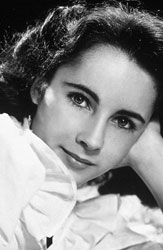 |
| Already a child star in the film National Velvet in 1944 |
Even as a tiny tot, Elizabeth had an unsettling, exotic beauty, almost as though the head of a mature woman had been grafted onto the body of a child.
On the outbreak of war in 1939, her father moved his art dealership to Beverly Hills, California, starting a gallery whose clients came to include actor Edward G. Robinson and writer-director Billy Wilder.
Sara, a ‘stage mother’ of the pushiest kind, steered her violet-eyed little girl into a contract with MGM studios, whose patriarchal boss, Louis B. Mayer, boasted owning ‘more stars than there are in Heaven’.
Taylor’s drive to succeed was the equal of her mother’s. After a taste of fame in Lassie Come Home aged ten, 12-year-old Elizabeth set her heart on the lead role in National Velvet, a romance with a horse racing background, but was told she was too short for the role.
After several weeks of punishing exercise and weight-gaining diet, she went back to the director and managed to persuade him she’d gained three inches in height.
Child stars then seldom made a comfortable transition to adult roles — witness Shirley Temple — but Taylor managed it effortlessly. With her virginal beauty went a voluptuous figure that initially worried the self-censoring movie bosses. Officials known as B.I.s (bust-inspectors) patrolled her sets, ordering higher-cut dresses if too much cleavage was visible.
At 18, she married Nicky Hilton, a good-looking and deceptively charming young man whose father, Conrad, had founded the Hilton hotel group.
The smiling charmer proved to be an abusive drunk who battered his young bride so brutally that she lost the baby she had been carrying.
Divorcing Hilton, Elizabeth rebounded into the arms of British actor Michael Wilding, a man 20 years her senior. The five-year marriage produced two sons, Michael and Christopher, but, as Taylor herself admitted, it was more brother-sister relationship than love match.
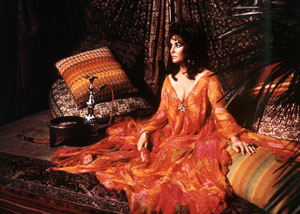 |
| Elizabeth Taylor on the set of Zee and Co in 1972 in which she played opposite Michael Caine |
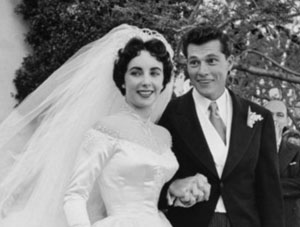 |
| Short-lived romance: In 1950, aged 18, she married Nicky Hilton, a deceptively charming young man whose father, Conrad, founded the Hilton hotel-chain. |
In 1957, she dumped Wilding for the American producer Mike Todd, a stocky, swashbuckling figure then preparing to launch his epic screen version of Jules Verne’s Around The World In 80 Days.
Todd was Taylor’s ideal man - powerful, protective and irresistibly masculine.
He adored her in the uncomplicated way she craved, treating her like bone china, showering her with jewels and furs, telephoning her every day no matter where in the world he was. Together they had a daughter, Liza, although complications during the birth required Taylor to undergo surgery to prevent any further pregnancies.
In March 1958, Todd took off on a business trip aboard the private aircraft he had named ‘The Lucky Liz’ in his wife’s honour.
Before he left, he couldn’t stop kissing her goodbye. ‘I’m afraid something’s going to happen,’ he told her. ‘I’m too happy.’
That night, en route for Kansas City, The Lucky Liz crashed in flames, killing Todd and everyone aboard.
Taylor was traumatised by his loss for years afterwards. Painkillers and drugs, which she’d begun using as a child star, were her only means of assuaging the pain, along with alcohol.
On screen, she was Hollywood’s nearest answer to smouldering European movie goddesses such as Gina Lollobrigida and Sophia Loren.
Her portrayal of the sexually yearning Maggie the Cat in Tennessee Williams’s Cat On A Hot Tin Roof and of Gloria Wandrous in Butterfield 8 (for which she won her first Oscar in 1960) fuelled the fantasies of men the world over.
But she also proved herself an actress of extraordinary depth and range, notably in Giant — a Texan epic presaging TV’s Dallas — in which she co-starred with heart-throb James Dean.
In May 1959 she married her fourth husband, the crooner Eddie Fisher, who had been bst man at her wedding to Todd. The pair had caused a scandal when Fisher left his then wife Debbie Reynolds for Elizabeth.
A year later, Taylor was filming Cleopatra, a historical epic so long-drawn-out and horrendously expensive that it would come near to bankrupting its producers. She was paid a then record-breaking $1m for her role.
Cast as Mark Antony, the Egyptian queen’s Roman lover, was Welsh actor Richard Burton, until then better known on the stage than the vulgar screen.
Taylor and Burton’s first scene together in Cleopatra produced instant, fizzing sexual chemistry. They held their first screen kiss for so long that the director called out sarcastically: ‘I’m sorry to interrupt you two... but it’s time for lunch.’
Their public love affair caused a scandal since Taylor was still married to Eddie Fisher and Burton to his well-known and popular first wife, Sybil. The then Pope even took a hand, castigating Taylor for stealing another woman’s husband.
Married in 1964, ‘the Burtons’ as they became known, created a dazzling screen and stage partnership, appearing together in Shakespeare’s The Taming Of The Shrew and Marlowe’s Dr Faustus. Unable to have children of their own, the couple adopted a little girl named Maria from a Munich orphanage.
In 1966, they played warring husband and wife in Edward Albee’s Who’s Afraid of Virginia Woolf? for which Taylor won a second Oscar.
Their extravagance was like nothing the post-war world had seen before. Burton bought Taylor the world’s largest diamond for a then staggering £1.1 million, as well as other jewels, furs, old masters and a luxury yacht. I was once shown over the yacht, and invited to experience the sensation of rolling on the Burtons’ circular bed.
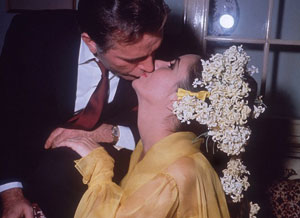 |
| Legends: Taylor with Richard Burton on their first wedding day in 1964. He was to be her fifth and sixth husband |
Taylor seemed to commit herself wholeheartedly to Burton, even learning Welsh (which she would use to swear at him during their rows) and valiantly trying to curb her natural chaotic untidiness. When I met her parents, they told me in amazement how, since meeting Burton, she’d got into the habit of emptying ashtrays.
But the grand passion was sabotaged by drink and by Burton’s growing bitterness at having compromised his talent by accepting second-rate film roles, as he thought, to keep Taylor in the luxury she demanded. As disenchantment grew, his pet name for her changed from ‘Ocean’ to ‘Tubby’.
Having turned their marriage into a real-life Edward Albee hell, they divorced in 1974, remarried in 1975 but parted for good a year later. Burton died in 1984 from a brain haemorrhage.
Marriage number seven was to John Warner, a rather dull American politician then seeking election to the Senate. Taylor threw herself into the role of Washington wife, even selling the diamond Richard Burton had given her to fund Warner’s election campaign.
No longer in demand in Hollywood, her weight ballooned alarmingly. Seeing the cruel photographs of her with Warner in the late Seventies, I remembered her father’s innocent observation — long before anyone knew about ‘eating disorders’ — that she would routinely eat five hot dogs with bacon, one after another.
Warner and Taylor were divorced in 1982, and two years later came the strangest attachment of all when she began a friendship with Michael Jackson, then the world’s most famous and most bizarre rock megastar.
The 52-year-old Hollywood matriarch and the 26-year-old, white-gloved moonwalker were reportedly trembling on the brink of matrimony. Taylor insisted that, for all his fixations on childhood and his obsessive facial restructuring, Jackson was the most ‘normal’ person she’d ever met. This even though Jackson at one point considered altering his appearance yet again to become a living replica of Taylor as a young girl in her 1944 film National Velvet.
Always a prey to dramatic illnesses and accidents, she suffered grievous ill health as the years advanced, almost dying from viral pneumonia in 1990 and developing chronic osteo-arthritis that necessitated two hip operations and left her more than ever reliant on painkilling drugs and alcohol.
In 1988, while drying out at the Betty Ford Clinic, she lost her heart again, to a construction worker named Larry Fortensky, 21 years her junior, who was tackling his own alcoholism. They married in 1991 at Michael Jackson’s Neverland ranch, with ex-presidents Reagan and Ford among the guests and Jackson picking up the $1 million tab. As a thank you, Taylor bought the singer an elephant named Gipsy.
The relationship between former goddess and her ‘bit of rough’ lasted a surprising eight years, although for most of that time Fortensky looked more like Taylor’s bodyguard than her husband.
He was eventually dismissed with a pay-off of £1.3m and returned to his job as a construction worker with, doubtless, a few stories to tell the other lads on site.
So why did Taylor keep marrying until eventually scoring higher than Henry VIII? Her old friend Roddy McDowall thought it pointed to a deeply old-fashioned nature. ‘When Elizabeth falls for someone, she doesn’t just fall into bed with them,’ McDowall told me. ‘She has to make it legitimate.’
In 1997, a year after her divorce from Fortensky, Taylor underwent a successful operation on a benign brain tumour, emerging with her once-luxuriant dark curly hair now close-cropped and white. Her movie and TV career behind her (except for occasional forays like voicing baby Maggie in The Simpsons cartoon), she no longer needed a Mike Todd or Burton to buy her diamonds.
A range of perfumes marketed in her name had boosted a fortune then estimated at £100m. She became a tireless campaigner for Aids awareness and, by her own gutsy refusal to go under, despite her mounting health problems, a symbol of courage for women everywhere.
In 2000, she paid her first visit to her homeland for many years to be invested as a Dame by the Queen and be honoured by the UK film industry. Though often confined to a wheelchair, she still managed to look spectacular and seem as down-to-earth as ever (despite having sent an advance demand that her Dorchester Hotel suite be repainted violet to match her eyes).
‘A Dame?’ she echoed to one interviewer in amazement. ‘I didn’t think I was the kind of person that happened to.’
Thereafter, she became increasingly frail and wheelchair-bound, and behind the lavender-drenched walls of her Bel Air mansion, she came increasingly to resemble Norma Desmond, Sunset Boulevard’s has-been screen goddess. Indeed, Desmond’s great snarl of defiance in the movie could equally have been written for Taylor. ‘I’m still big. It’s the pictures that got small.’
The years may have been remorselessly advancing, but her famous sexual magnetism still flickered fitfully. She was even said to be contemplating a ninth wedding, this time to an LA property developer named Jason Winters, 28 years her junior.
A disaffected landscape gardener who left her employment also claimed she had demanded sex from her bisexual French butler, who was wont to refer to her disparagingly as ‘the old trampoline’.
To refute claims that her formidable list of ailments now included Alzheimer’s disease, she appeared on Larry King’s TV talk show in 2006, dressed in a lime green and purple kaftan and sporting, as she liked to say, ‘more bling than J-Lo’.
As a further sock in the eye to would-be obituaritists, she flew to Hawaii and had herself winched into the water in a cage to enjoy the experience of swimming with sharks.
Burton remained the love of her life, run a close second by Mike Todd. She often spoke of being buried near Burton’s childhood home in South Wales even though the actor’s grave is actually in Switzerland, where he died in 1984.
Indeed, it was as one half of the world’s most glamorous double act, Burton and Taylor - or Antony and Cleopatra - that she was at her most beautiful, most spectacularly impossible and professionally brilliant.
I often think back to having dinner with the two of them in Salzberg in 1968, how kind they were to a young journalist and the moment Taylor’s amazing violet eyes turned directly on me.
Even that 43-year-old memory still takes my breath away.
© Daily Mail, London |

